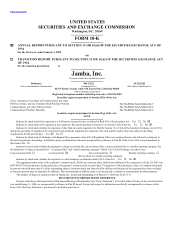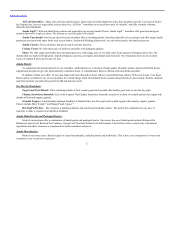Jamba Juice 2008 Annual Report Download - page 6
Download and view the complete annual report
Please find page 6 of the 2008 Jamba Juice annual report below. You can navigate through the pages in the report by either clicking on the pages listed below, or by using the keyword search tool below to find specific information within the annual report.
Table of Contents
A primary goal of the Company is to build accessibility, meaning making it easier for customers to experience Jamba. One way to accomplish that goal
is to expand the number of Jamba Juice stores. We have grown our concept and brand through company owned and operated stores (“Company Stores”) and
franchise locations (“Franchise Stores”). As of January 1, 2008, there were 707 Jamba Juice locations consisting of 501 Company Stores and 206 Franchise
Stores operating in 22 states and the Bahamas. Except for the single Bahamas franchise location we have no other international locations. Of the 707 locations,
373 stores are located in California, of which 335 are Company Stores. We lease the real estate for all of our Company Stores.
We generally characterize our stores as either “traditional” or “non-traditional” locations. Traditional locations are characterized as a business premise
that exists primarily as a Jamba Juice store. Traditional stores average approximately 1,400 square feet in size and are designed to be fun, friendly, energetic
and colorful to represent the active, healthy lifestyle that we promote. These stores are located either in major urban centers or in suburban strip mall centers.
As of January 1, 2008, there were 608 traditional Jamba Juice store locations.
Non-traditional locations are characterized as a Jamba Juice store located within another primary business or in conjunction with other businesses or at
institutional settings such as colleges and universities, schools, shopping malls, supermarkets and airports. A “captive” audience is a common characteristic
of non-traditional locations. As of January 1, 2008, there were 99 non-traditional Jamba Juice store locations.
All Jamba Juice stores are designed to provide a highly interactive Jamba experience to build our customer relationship, including the enticing aroma of
fresh fruit, vegetables and wheatgrass, the high-energy sounds of whirring blenders and team members calling out greetings. The construction and color
scheme employed at the stores provide a bright and cheerful “marketplace” theme with colors that embody our commitment to fresh and healthy juices,
smoothies and other energizing products. Additionally, stores focus on the “theater” aspect of smoothie making by providing an environment in which all food
preparation is conducted behind glass and in the open for customers to watch as the juices and smoothies are made with all-natural ingredients. The layout
offers a casual bar-type atmosphere using interior stools and exterior tables and chairs. Glass cases display baked goods and shelving in front of cash registers
allow for the sale of baked goods and prepackaged healthy snack items.
Our typical costs to construct a Company Store range from approximately $325,000 to over $500,000 depending upon location.
Our franchising program is currently conducted via (i) traditional store venues such as single store franchises to a franchisee, (ii) franchises granted for
non-traditional store venues and (iii) exclusive multi-unit license agreements in which the franchisee develops and operates a specified number of stores within
a specified period of time within a specified geographic area, which we call area development agreements.
Our current franchise agreement provides for a 10-year term. The agreement is renewable for an additional 10-year term, subject to various conditions
and state law. The royalty rate is typically 5% of revenue, with franchisees required to contribute up to an additional 4% of revenue (2% for a non-traditional
store) to a company-administered marketing fund. At the present time, in general, we are charging 2.5% and 2.0% of revenue as the marketing contribution for
our traditional and non-traditional franchisees, respectively. There is typically a one-mile geographic radius restriction for traditional stores in non-downtown
areas.
Franchisees typically pay an initial fee ranging from $15,000 for non-traditional store locations to $25,000 for traditional store locations. We do not
provide financing to our franchisees. However, we may consider a joint venture investment in certain circumstances. Franchisees are obligated to finance their
own build-out of the store location according to our specifications.
6



















